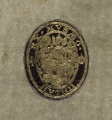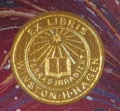Provenance: Difference between revisions
m (→Cataloging policy: rephrased) |
(→Cataloging policy: Changed recipient to addressee) |
||
| (One intermediate revision by one other user not shown) | |||
| Line 9: | Line 9: | ||
=== Internal === | === Internal === | ||
==== | ==== Autographs ==== | ||
Owner's names appear in many places in early modern books. While title pages and the first leaf of the text are common, names may appear throughout the work, and you can often find signatures on the final leaf or at random locations in the middle of a text. | Owner's names appear in many places in early modern books. While title pages and the first leaf of the text are common, names may appear throughout the work, and you can often find manuscript signatures on the final leaf or at random locations in the middle of a text. | ||
<gallery> | <gallery> | ||
| Line 33: | Line 33: | ||
Current cataloging policy for Vault material calls for noting [[Former owners|former owners]], evidence of former owners, and the immediate source of acquisition. For example, the Hamnet record for [http://hamnet.folger.edu/cgi-bin/Pwebrecon.cgi?BBID=245419 Folger call number STC 24878.3] includes the notes "Stamp: Julia E. Chafyn-Grove, Zeals House, Bath" and "Purchased from Sokol Books, 2011.05.17," and the name access point "Chafyn-Grove, Julia E., d. 1897, former owner." | Current cataloging policy for Vault material calls for noting [[Former owners|former owners]], evidence of former owners, and the immediate source of acquisition. For example, the Hamnet record for [http://hamnet.folger.edu/cgi-bin/Pwebrecon.cgi?BBID=245419 Folger call number STC 24878.3] includes the notes "Stamp: Julia E. Chafyn-Grove, Zeals House, Bath" and "Purchased from Sokol Books, 2011.05.17," and the name access point "Chafyn-Grove, Julia E., d. 1897, former owner." | ||
* Record any physical provenance evidence, such as inscriptions, bookplates, binder's stamps, etc., as a free-text public note in the [[MARC_852_Location#.C7.82z_Public_note|852 ‡z]]. Record the immediate source of acquisition in the 852 ‡z as well. | * Record any physical provenance evidence, such as inscriptions, bookplates, binder's stamps, etc., as a free-text public note in the [[MARC_852_Location#.C7.82z_Public_note|852 ‡z]]. Record the immediate source of acquisition in the 852 ‡z as well. | ||
* Note former owners in a [[MARC X00 Personal Names - General Information|MARC 700]] or [[MARC X10 Corporate Names - General Information|710]] field, followed by a [[Relationship designators|relationship designator]]. For most name access points for former owners, this will be "former owner", but more specific terms may sometimes be applicable. For example, " | * Note former owners in a [[MARC X00 Personal Names - General Information|MARC 700]] or [[MARC X10 Corporate Names - General Information|710]] field, followed by a [[Relationship designators|relationship designator]]. For most name access points for former owners, this will be "former owner", but more specific terms may sometimes be applicable. For example, "addressee" after the name of the addressee of a letter implies ownership. | ||
**'''Note''': do not create access points when the immediate source of acquisition is a commercial bookseller or vendor. | **'''Note''': do not create access points when the immediate source of acquisition is a commercial bookseller or vendor. | ||
* Add [[genre and form]] terms to a [[MARC 655 Index Term - Genre/Form|655]] field as appropriate to describe the physical provenance evidence of an item, such as Armorial bindings, Insertions, Presentation inscriptions, etc. | * Add [[genre and form]] terms to a [[MARC 655 Index Term - Genre/Form|655]] field as appropriate to describe the physical provenance evidence of an item, such as Armorial bindings, Insertions, Presentation inscriptions, etc. | ||
Latest revision as of 11:12, 4 May 2024
Provenance is the record of ownership of an object. Provenance can be established through external records, such as sales receipts and booksellers' ledgers, and through internal marks and additions, such as ownership inscriptions and bookplates.
Types of evidence for establishing provenance
External
Many of the former owners of Folger items collected more than books. Letters, miscellanies, receipts, ledgers, and library catalogs help trace books as they passed from one person or institution to another. For more information on specific former owners, the Folger's finding aids are a useful resource in addition to Hamnet. For example, Edwin Booth's letters discuss his dealings with booksellers (both buying and selling), his own writing, and books that he read.
Internal
Autographs
Owner's names appear in many places in early modern books. While title pages and the first leaf of the text are common, names may appear throughout the work, and you can often find manuscript signatures on the final leaf or at random locations in the middle of a text.
Bookplates
Bookplates come in many sizes and materials including leather and vellum, but are commonly made of paper and pasted onto the front pastedown or flyleaves of the book. Bookplates often feature heraldic symbolism and family mottos. The Folger's own bookplate, which features Shakespeare's coat of arms, is often tipped to the back pastedown to avoid obscuring earlier provenance information.
The term "Ex Libris," often found on bookplates, translates as "From the library of."
Stamps and embossing
Cataloging policy
The Folger has a long history of providing access to collection materials by former owners' names. The "Former owner" card file can still be found in the card catalog room.
Current cataloging policy for Vault material calls for noting former owners, evidence of former owners, and the immediate source of acquisition. For example, the Hamnet record for Folger call number STC 24878.3 includes the notes "Stamp: Julia E. Chafyn-Grove, Zeals House, Bath" and "Purchased from Sokol Books, 2011.05.17," and the name access point "Chafyn-Grove, Julia E., d. 1897, former owner."
- Record any physical provenance evidence, such as inscriptions, bookplates, binder's stamps, etc., as a free-text public note in the 852 ‡z. Record the immediate source of acquisition in the 852 ‡z as well.
- Note former owners in a MARC 700 or 710 field, followed by a relationship designator. For most name access points for former owners, this will be "former owner", but more specific terms may sometimes be applicable. For example, "addressee" after the name of the addressee of a letter implies ownership.
- Note: do not create access points when the immediate source of acquisition is a commercial bookseller or vendor.
- Add genre and form terms to a 655 field as appropriate to describe the physical provenance evidence of an item, such as Armorial bindings, Insertions, Presentation inscriptions, etc.
- If the Folger owns multiple copies of an item, specify which copy the provenance information belongs to in a subfield ‡3.
- Refer to accession numbers that indicate former owners for accession numbers associated with bulk acquisitions.



